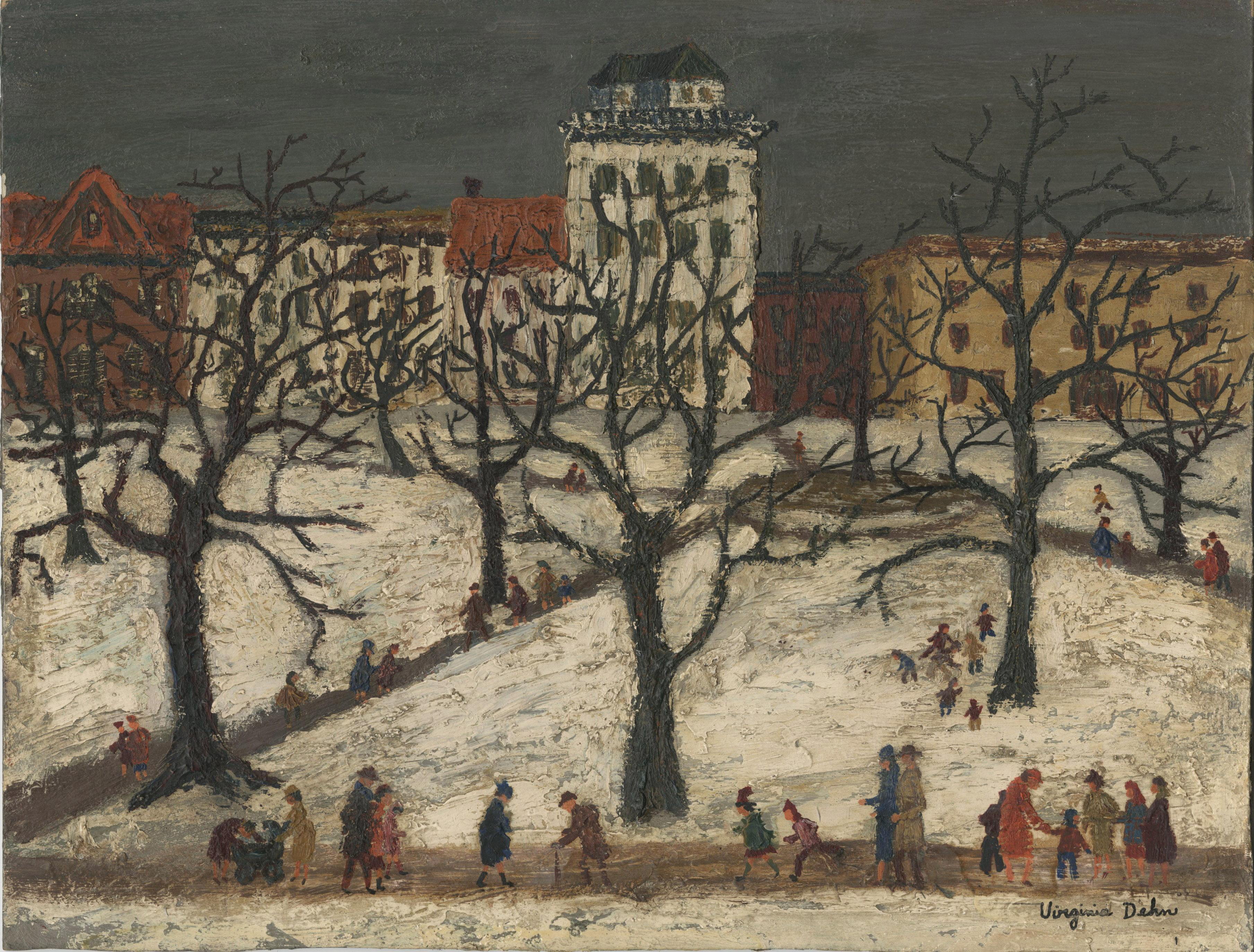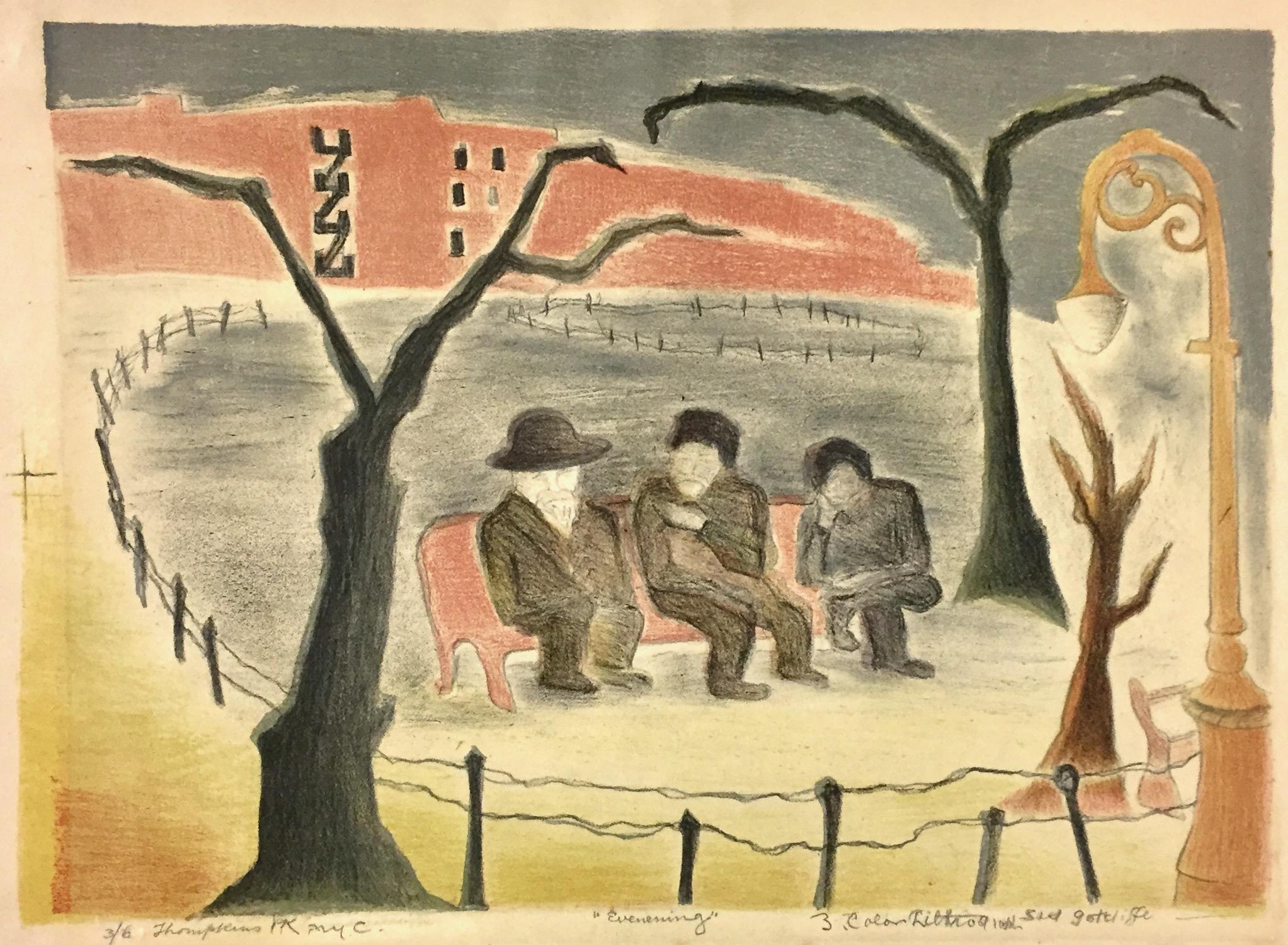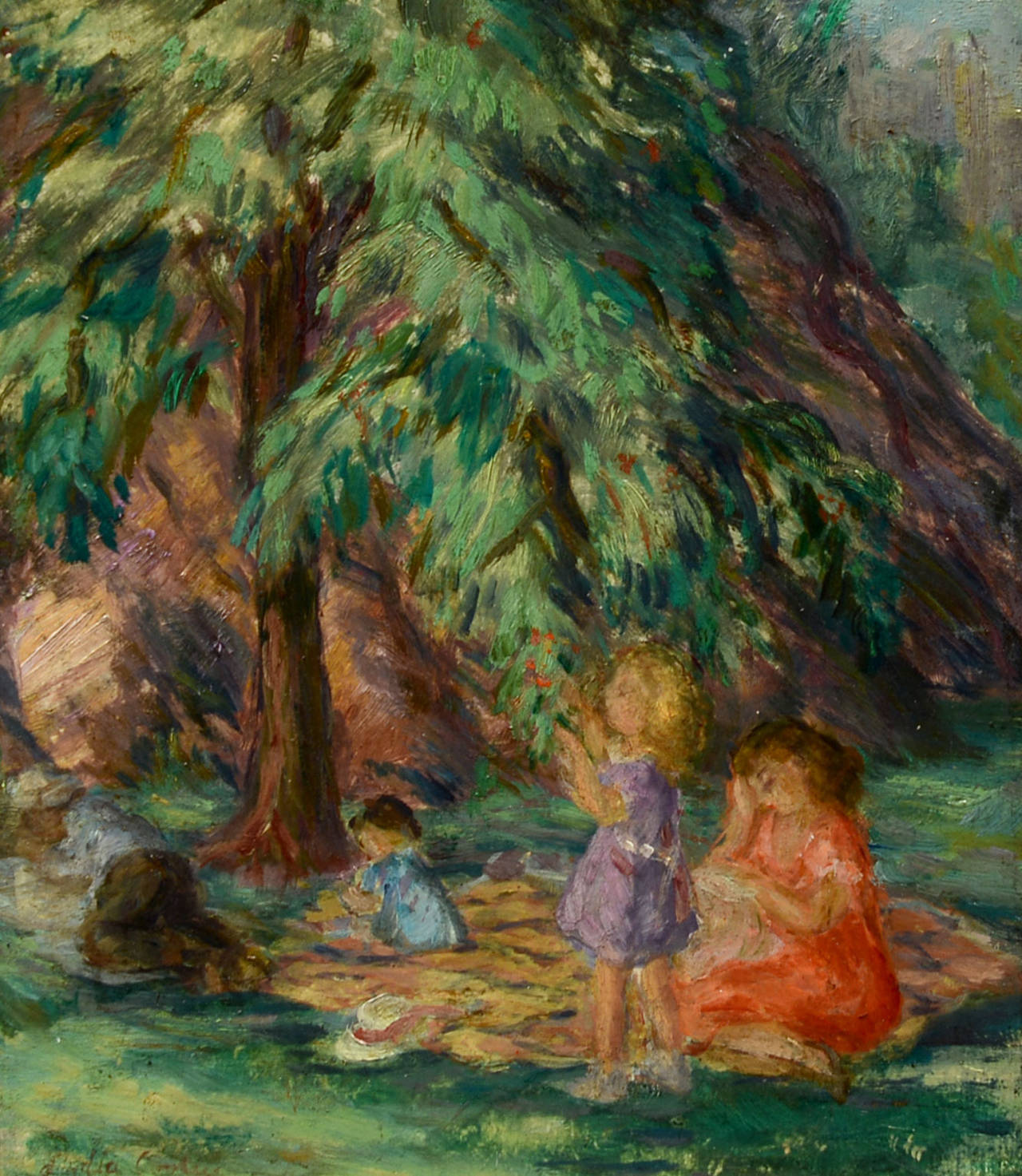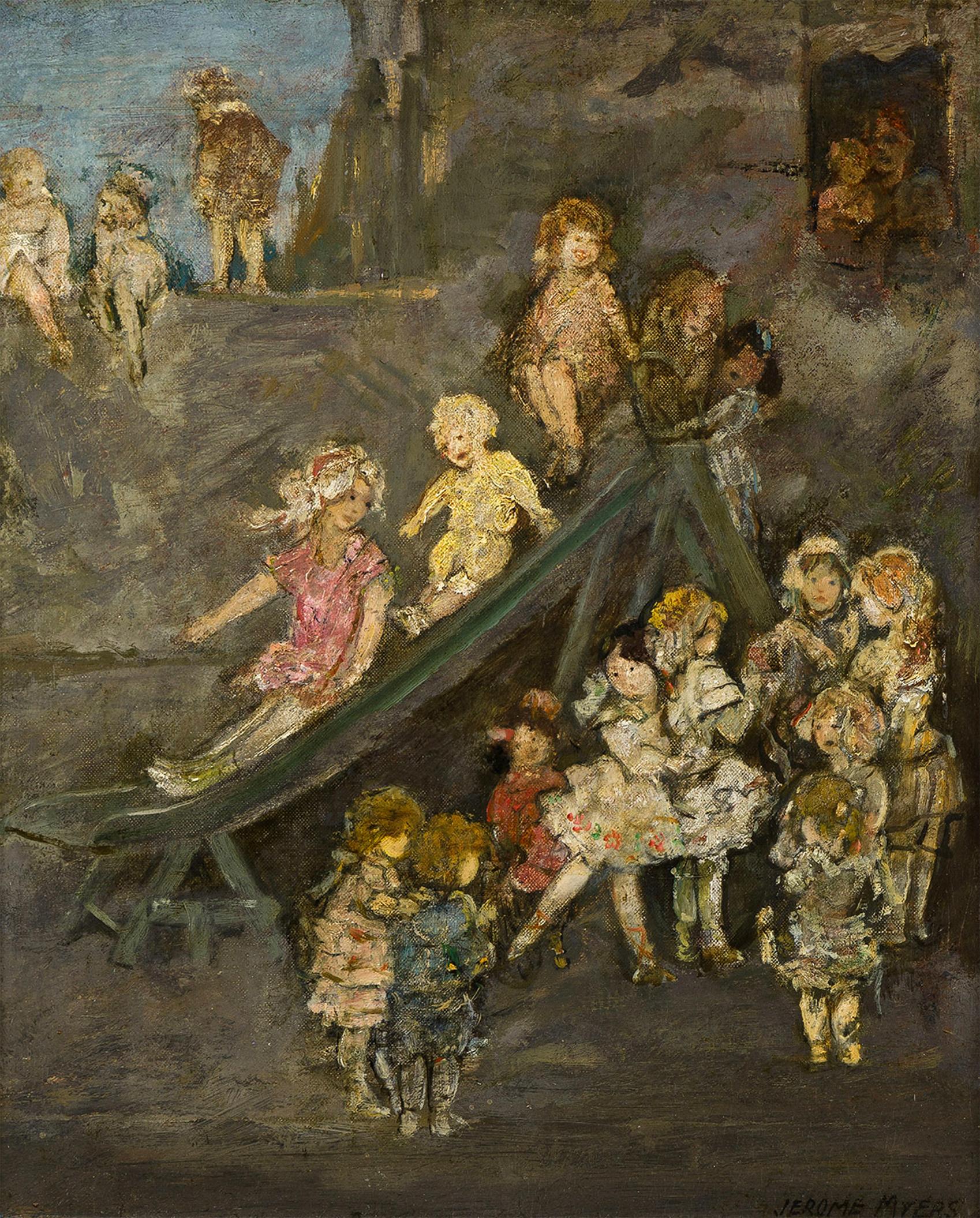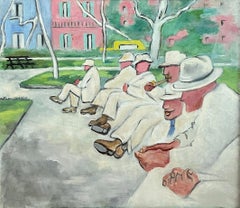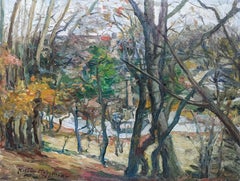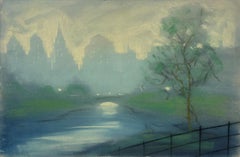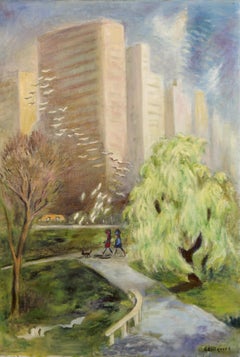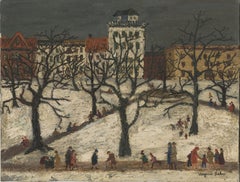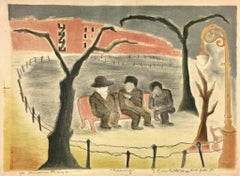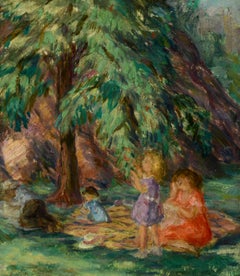Items Similar to "Playground, Carl Schurz Park" George Picken, New York City, East River, UES WPA
Want more images or videos?
Request additional images or videos from the seller
1 of 10
George Picken"Playground, Carl Schurz Park" George Picken, New York City, East River, UES WPA1938
1938
$22,400
$28,00020% Off
£17,005.70
£21,257.1220% Off
€19,450.89
€24,313.6120% Off
CA$31,296.05
CA$39,120.0620% Off
A$34,808.04
A$43,510.0520% Off
CHF 18,175.68
CHF 22,719.5920% Off
MX$423,576.79
MX$529,470.9820% Off
NOK 232,131.11
NOK 290,163.8920% Off
SEK 217,698.03
SEK 272,122.5420% Off
DKK 145,169.45
DKK 181,461.8120% Off
Shipping
Retrieving quote...The 1stDibs Promise:
Authenticity Guarantee,
Money-Back Guarantee,
24-Hour Cancellation
About the Item
George Picken
Playground, Carl Schurz Park, 1938
Signed and dated lower left
Oil on canvas
28 x 36 inches
Provenance:
Estate of the artist
A native New Yorker, George Picken was born in 1898. His father, an artist and photographer, emigrated from Scotland; his mother came from Wales. They joined other European immigrants settling in New York City’s Hell’s Kitchen. Picken enlisted in the army during World War I and saw action at Verdun. After the war, he stayed in France and like many Americans returning from the vibrant Paris art scene, was inspired by the radical movement known as Impressionism. Upon his return Picken decided to follow in his father’s footsteps and become an artist.
George began his studies in 1919 at the Art Students League during Robert Henri, Max Weber, and John Sloan’s tenure. There he took classes in studio art, illustration, and etching through 1923 studying extensively with George Bridgman. The writings of French philosopher Henri Bergson were widely circulated among the artistic community and looking at Picken’s early paintings one cannot help but wonder if as a young artist he was influenced by Bergson’s ideas. Bergson said, "[There are] two profoundly different ways of knowing a thing. The first implies that we move round the object; the second that we enter into it. The first depends on the point of view at which we are placed and on the symbols by which we express ourselves. The second neither depends on a point of view nor relies on any symbol. The first kind of knowledge may be said to stop at the relative; the second, in those cases where it is possible, to attain the absolute.”
Picken’s recognition came early with showings of his work while he was a student. His drawings were published in the New Masses, a significant left-wing publication. The New York Public Library honored him with one-man shows in 1924 and 1928 and his work was included in group exhibitions at the Louis Comfort Tiffany Foundation, the Whitney Studio Club, Montross Gallery, and the Art Students League. During this time Picken married Viola Carton, one of Reginald Marsh’s models, and they lived in Westchester. Later they moved to Yorkville in Manhattan between 82nd street and East End Avenue where they began their family. Picken’s grandson Niles Jaeger recalled that, “Grandpa’s home and studio were in a five-story walk-up apartment, heated only by a coal stove. But there were wonderful views of the East River and the Queensborough Bridge and he painted them repeatedly over the next three decades.”
Picken felt the financial panic and economic depression that engulfed most of the world in 1931; [he] was trying to support a wife and two children on his earnings as an artist….Franklin Delano Roosevelt promised “a new deal for the American people” at the 1932 Democratic Convention [and] the Federal Art Project was formed. During the run of the [WPA] over ten thousand artists were employed including Picken’s friends Stuart Davis and Reginald Marsh. Arshile Gorky, Isabel Bishop, Grant Wood, Ben Shahn, Adolph Gottlieb, David Smith, Willem deKooning, Jackson Pollock, Mark Rothko, Ad Reinhardt, and Paul Cadmus also found work. Along with Rockwell Kent, John Steuart Curry, and Thomas Hart Benton, Picken was commissioned to do public murals. Picken’s work can be found in the Post Offices of Hudson Falls and Fort Edward, New York and Chardon, Ohio. He also completed public murals for St. Ambrose Church in Brooklyn and Hawthorne Public School in Hawthorne, New York.
In 1933 George Picken was also offered a position as a teacher at the Art Students League. He taught printmaking there through 1942 as well as teaching painting, printmaking, and lithography at Cooper Union and holding a position at Columbia University. During this time Picken achieved notoriety for his paintings of industrial and city scenes like Mining Town. Stuart Davis remarked that his friend’s dark urban scenes were like “dungeons.” Marie Harriman, wife of railroad baron Averill Harriman, was Picken’s first patron giving him one-person shows at her gallery. In the 1940s with the guidance of Edward Hopper, Picken joined the prestigious Rehn Galleries on Madison Avenue. Rehn Galleries also exhibited the work of Reginald Marsh and Charles Burchfield. Picken’s had regular one-person shows there until his death.
George Picked retired to Tyringham and continued painting and gardening until his death at the age of seventy-three in 1971. Picken’s work is in many private and public collections including the Whitney Museum of American Art, The Corcoran Gallery of Art, The Metropolitan Museum of Art, Dartmouth College, the Kansas City Art Institute, the Smithsonian Institution, the Library of Congress, the Parrish Art Museum, Syracuse University, the Art Students League, and the Newark Museum.
- Creator:George Picken (1898 - 1971, American)
- Creation Year:1938
- Dimensions:Height: 35 in (88.9 cm)Width: 43 in (109.22 cm)
- Medium:
- Movement & Style:
- Period:
- Condition:Lined canvas.
- Gallery Location:New York, NY
- Reference Number:1stDibs: LU1841212374252
George Picken
A native New Yorker, George Picken was born in 1898. His father, an artist and photographer, emigrated from Scotland; his mother came from Wales. They joined other European immigrants settling in New York City’s Hell’s Kitchen. Picken enlisted in the army during World War I and saw action at Verdun. After the war, he stayed in France and like many Americans returning from the vibrant Paris art scene, was inspired by the radical movement known as Impressionism. Upon his return Picken decided to follow in his father’s footsteps and become an artist. George began his studies in 1919 at the Art Students League during Robert Henri, Max Weber, and John Sloan’s tenure. There he took classes in studio art, illustration, and etching through 1923 studying extensively with George Bridgman. Picken’s recognition came early with showings of his work while he was a student. His drawings were published in the New Masses, a significant leftwing publication. The New York Public Library honored him with one-man shows in 1924 and 1928 and his work was included in group exhibitions at the Louis Comfort Tiffany Foundation, the Whitney Studio Club, Montross Gallery, and the Art Students League. Later he moved to Yorkville in Manhattan between 82nd street and East End Avenue where they began their family. Picken’s grandson Niles Jaeger recalled that, “Grandpa’s home and studio were in a five-story walk-up apartment, heated only by a coal stove. But there were wonderful views of the East River and the Queensborough Bridge and he painted them repeatedly over the next three decades.” Picken felt the financial panic and economic depression that engulfed most of the world in 1931. During the run of the [WPA] over ten thousand artists were employed including Picken’s friends Stuart Davis and Reginald Marsh. Arshile Gorky, Isabel Bishop, Grant Wood, Ben Shahn, Adolph Gottlieb, David Smith, Willem deKooning, Jackson Pollock, Mark Rothko, Ad Reinhardt, and Paul Cadmus also found work. Along with Rockwell Kent, John Steuart Curry, and Thomas Hart Benton, Picken was commissioned to do public murals. Picken’s work can be found in the Post Offices of Hudson Falls and Fort Edward, New York and Chardon, Ohio. In 1933 George Picken was also offered a position as a teacher at the Art Students League. He taught printmaking there through 1942 as well as teaching painting, printmaking, and lithography at Cooper Union and holding a position at Columbia University. During this time Picken achieved notoriety for his paintings of industrial and city scenes. Stuart Davis remarked that his friend’s dark urban scenes were like “dungeons.” Marie Harriman, wife of railroad baron Averill Harriman, was Picken’s first patron giving him one-person shows at her gallery. In the 1940s with the guidance of Edward Hopper, Picken joined the prestigious Rehn Galleries on Madison Avenue. Rehn Galleries also exhibited the work of Reginald Marsh and Charles Burchfield. Picken’s had regular one-person shows there until his death.
About the Seller
5.0
Platinum Seller
Premium sellers with a 4.7+ rating and 24-hour response times
Established in 2022
1stDibs seller since 2022
114 sales on 1stDibs
Typical response time: <1 hour
- ShippingRetrieving quote...Shipping from: New York, NY
- Return Policy
Authenticity Guarantee
In the unlikely event there’s an issue with an item’s authenticity, contact us within 1 year for a full refund. DetailsMoney-Back Guarantee
If your item is not as described, is damaged in transit, or does not arrive, contact us within 7 days for a full refund. Details24-Hour Cancellation
You have a 24-hour grace period in which to reconsider your purchase, with no questions asked.Vetted Professional Sellers
Our world-class sellers must adhere to strict standards for service and quality, maintaining the integrity of our listings.Price-Match Guarantee
If you find that a seller listed the same item for a lower price elsewhere, we’ll match it.Trusted Global Delivery
Our best-in-class carrier network provides specialized shipping options worldwide, including custom delivery.More From This Seller
View All"Washington Square Park" Georgina Klitgaard, People in Cityscape Modernist Scene
By Georgina Klitgaard
Located in New York, NY
Georgina Klitgaard
Washington Square Park, New York
Oil on canvas
25 1/2 x 31 inches
Georgina Klitgaard’s art has sometimes gotten lost in the critical propensity to assign artists...
Category
Early 20th Century American Modern Figurative Paintings
Materials
Canvas, Oil
"Prospect Park, Brooklyn, " Nathan Hoffman, New York City Impressionist Landscap
Located in New York, NY
Born in Russia, the son of Friede (1878 – 1956) and Benjamin Hoffman (1878 – a. 1942). Benjamin was a dealer in mineral and seltzer water and the family resided on Snediker Avenue in Brooklyn, New York, just down the streetfrom the home where George Gershwin (1898 – 1937) was born.
This area of Brooklyn, known as Brownsville, “witnessed the development of one of the largest communities of Eastern European Jewish immigrants during the last decade of the 19th century and the first two decades of the 20 th century.” Today, little remains of this once thriving Jewish section of Brooklyn, which today houses many commercial and repair businesses.
Hoffman studied at the Art Students League of New York, the National Academy of Design and in the art program at Cooper Union. His work at the National Academy received praise, and in 1921 he was awarded the 2nd prize and an honorable mention from the John Armstrong Chaloner Paris Prize Foundation at the National Academy, which allowed the recipient to study in Paris, France for as long as five years. The following year he was awarded the 1 st prize in the competition (with The Reform Advocate running the headline “Young Jew Wins Art Prize”) as well as the Suydam Bronze Medal for his achievements in the Academy’s Men’s Night Class. In 1923 he was residing in Long Branch, New Jersey, when he was awarded 4th place in the Chaloner competition.
Early on, Hoffman exhibited his work throughout the city, including in 1925 with the recently organized Society of Independent Artists. He also received several solo exhibitions during the first part of his career, including one at Ferargil Galleries in 1929. In the spring of 1930 a solo exhibition of his portraits, including paintings and drawings, was held at at Babcock Galleries, where a reviewer noted: “Portraiture is obviously Mr. Hoffman’s specialty… his best work is characterized by a sensitive appreciation of character set down in a vigorous decisive statement.
Later that same year, in August, he participated in Babcock’s summer exhibition where reviewer Jerome Klein, writing for The Baltimore Sun, felt Hoffman’s and other artists work was already becoming old fashioned, remarking “…if an effort toward accomplishment is to be made, it must be in the language of today. It is for that reason that such contemporaries as Eugene Higgins and Nathan Hoffman, in this show, seem artists of a bygone era…” The onset of the Great Depression appears to have slowed his success, as was the case for many up-and-coming artists.
By 1939 Hoffman had become a gallerist in addition to being a painter, operating the collective exhibition space “Sutton Gallery,” which was originally located at 358 East 57th Street. There Hoffman exhibited his own works as well as those created by other prominent New York artists including David Burliuk (1882 – 1967), Charles C. Curran (1861 – 1942), Louis Eilshemius (1864 – 1941), Ann Goldthwaite (1869 – 1944), Maurice Kish (1895 – 1987), Lawrence Lebduska (1894 – 1966), Bradford Perin and Ellis Wilson...
Category
1940s Post-Impressionist Landscape Paintings
Materials
Oil, Board
"Central Park" Leon Dolice, New York Central Park Scene, Mid-Century
By Leon Dolice
Located in New York, NY
Leon Dolice
Central Park
Signed lower left
Watercolor on paper
12 x 19 inches
The romantic backdrop of Vienna at the turn of the century had a life-long influence upon the young ma...
Category
1930s American Modern Figurative Drawings and Watercolors
Materials
Paper, Pastel
$2,400 Sale Price
20% Off
"Central Park South" Georgina Klitgaard, Female Modernist New York Cityscape
By Georgina Klitgaard
Located in New York, NY
Georgina Klitgaard
Central Park South
Signed lower right
Oil on canvas
40 1/2 x 28 inches
Georgina Klitgaard’s art has sometimes gotten lost in the critical propensity to assign ar...
Category
Early 20th Century American Modern Landscape Paintings
Materials
Oil
"Central Park, Sherry Netherland Hotel, Plaza Hotel" Nathan Hoffman, New York
Located in New York, NY
Nathan Hoffman
Central Park, Sherry Netherland Hotel, and Plaza Hotel, 1970
Signed, dated, titled on the reverse
Oil on artists board
10 x 16 inches
B...
Category
1940s American Impressionist Landscape Paintings
Materials
Oil, Board
"Building the Westside Highway" Frida Gugler, 1930s New York City Urban Scene
Located in New York, NY
Frida Gugler
Building the Westside Highway (Near the George Washington Bridge), circa 1935-37
Signed lower right
Oil on canvas
20 x 28 inches
Born in Milwaukee, Wisconsin, the pain...
Category
1930s American Realist Figurative Paintings
Materials
Canvas, Oil
You May Also Like
Park Scene (Chelsea, Manhattan)
By Virginia Dehn
Located in Fairlawn, OH
Park Scene (Chelsea, Manhattan)
Oil on artist's board, c. 1947-49
Signed lower right (see photo)
Provenance: Estate of the artist
Dehn Heirs
Condition: Good, needs a light cleaning
Original wormy chestnut frame
Painting size: 9 1/4 x 12 inches
Frame size: 14 1/4 x 17 inches
One of the earliest know Virginia Dehn paintings after her marriage to Adolf in 1947. The lived in Chelsea at 433 West 21st St.
Inscription by artist verso:
Virginia Dehn
443 W. 21 St.
New York City
V.70
Virginia Dehn
From Wikipedia, the free encyclopedia
Virginia Dehn
Virginia Dehn in her studio in Santa Fe
Virginia Dehn (née Engleman) (October 26, 1922 – July 28, 2005) was an American painter and printmaker. Her work was known for its interpretation of natural themes in almost abstract forms. She exhibited in shows and galleries throughout the U.S. Her paintings are included in many public collections.
Life
Dehn was born in Nevada, Missouri on October 26, 1922.] Raised in Hamden, Connecticut, she studied at Stephens College in Columbia, Missouri before moving to New York City. She met the artist Adolf Dehn while working at the Art Students League. They married in November 1947. The two artists worked side by side for many years, part of a group of artists who influenced the history of 20th century American art. Their Chelsea brownstone was a place where artists, writers, and intellectuals often gathered.
Early career
Virginia Dehn studied art at Stephens College in Missouri before continuing her art education at the Traphagen School of Design, and, later, the Art Students League, both located in New York City. In the mid-1940s while working at the Associated American Artists gallery, she met lithographer and watercolorist Adolf Dehn. Adolf was older than Virginia, and he already enjoyed a successful career as an artist. The two were married in 1947 in a private ceremony at Virginia's parents house in Wallingford, Connecticut.
Virginia and Adolf Dehn
The Dehns lived in a Chelsea brownstone on West 21st Street where they worked side by side. They often hosted gatherings of other influential artists and intellectuals of the 20th century. Among their closest friends were sculptor Federico Castellón and his wife Hilda; writer Sidney Alexander and his wife Frances; artists Sally and Milton Avery; Ferol and Bill Smith, also an artist; and Lily and Georges Schreiber, an artist and writer. Bob Steed and his wife Gittel, an anthropologist, were also good friends of the Dehns. According to friend Gretchen Marple Pracht, "Virginia was a glamorous and sophisticated hostess who welcomed visitors to their home and always invited a diverse crowd of guests..." Despite their active social life, the two were disciplined artists, working at their easels nearly daily and taking Saturdays to visit galleries and view new work.
The Dehns made annual trips to France to work on lithographs at the Atelier Desjobert in Paris. Virginia used a bamboo pen to draw directly on the stone for her lithographs, which often depicted trees or still lifes. The Dehns' other travels included visits to Key West, Colorado, Mexico, and countries such as Greece, Haiti, Afghanistan, and India.
Dehn's style of art differend greatly from that of her husband, though the two sometimes exhibited together. A friend of the couple remarked, "Adolf paints landscapes; Virginia paints inscapes." Virginia Dehn generally painted an interior vision based on her feelings for a subject, rather than a literal rendition of it.] Many of her paintings consist of several layers, with earlier layers showing through. She found inspiration in the Abstract Expressionism movement that dominated the New York and Paris art scenes in the 1950s. Some of her favorite artists included Adolf Gottileb, Rothko, William Baziotes, Pomodoro, and Antonio Tapies.
Dehn most often worked with bold, vibrant colors in large formats. Her subjects were not literal, but intuitive. She learned new techniques of lithography from her husband Adolf, and did her own prints. Texture was very important to her in her work. Her art was influenced by a variety of sources. In the late 1960s she came across a book that included photographs of organic patterns of life as revealed under a microscope. These images inspired her to change the direction of some of her paintings. Other influences on Dehn's art came from ancient and traditional arts of various cultures throughout the world, including Persian miniatures, illuminated manuscripts, Dutch still life painting, Asian art, ancient Egyptian artifacts...
Category
1940s American Modern Landscape Paintings
Materials
Oil
Sid Gotcliffe, Tompkins Square Park, about 1940
By Sid Gotcliffe
Located in New York, NY
British-born Sid Gotcliffe has made a powerfully poignant image in the lithograph Tompkins Square Park.
At the center sit three men dressed in black. Their clothes suggest they bel...
Category
Mid-20th Century Ashcan School Figurative Prints
Materials
Lithograph
"Central Park Picnic, " Lydia Freeman Cooley, New York, figurative, ca 1930's
By Lydia Freeman Cooley
Located in Wiscasset, ME
Born in 1906, Cooley settled in New York City where she studied at the Arts Student League with John Sloan. Her genre paintings of women, children and the working class are in the As...
Category
1930s Impressionist Figurative Paintings
Materials
Oil
Vintage French Impressionist Paris Oversized Figural Park Scene Landscape 1960
Located in Douglas Manor, NY
3938 French Figural park landscape oil on canvas in a gilt wood frame
Image size 19.5x29.5"
I
Category
1960s Landscape Paintings
Materials
Oil
Vintage French Impressionist Paris Oversized Figural Park Scene Landscape 1960
Located in Douglas Manor, NY
3938 French Figural park landscape oil on canvas in a gilt wood frame
Image size 19.5x29.5"
I
Category
1960s Landscape Paintings
Materials
Oil
Children Playing on The Slide, Ashcan School - Lower East Side
By Jerome Myers
Located in Miami, FL
Immigrant children from New York's Lower East Side are joyfully captured whizzing down on a slide. From the window of a tenement building, a lone adult with child witnesses the foli...
Category
Early 1900s Ashcan School Figurative Paintings
Materials
Canvas, Oil
More Ways To Browse
Children In The Park Painting
Tiffany Live
Vintage Army Canvas
Mining Paintings
Gottlieb Adolph
Artist Painting Landscape Wpa
Vintage Dartmouth
Charles Church
Park Avenue Collection
Marsh Scene Paintings
Gorky Arshile
Louis Hudson
Hells Kitchen
Franklin Roosevelt
Railroad Oil Paintings
Edward Hopper Drawing
Wpa Mural Study
Nile Painting
